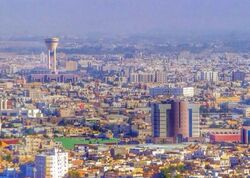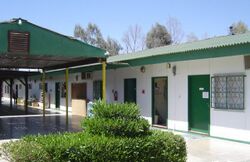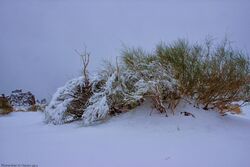Place:Tabuk, Saudi Arabia
Tabuk تَبُوْك | |
|---|---|
City | |
 Skyline of Tabuk | |
| Coordinates: [ ⚑ ] : 28°23′50″N 36°34′44″E / 28.39722°N 36.57889°E | |
| Country | |
| Province | Tabuk |
| Elevation | 760 m (2,490 ft) |
| Population (2021) | |
| • Total | 667,000 |
| Time zone | UTC+3 (AST) |
| Area code(s) | +966 14 |
Tabuk (Arabic: تَبُوْك Tabūk, Arabic: [tɐˈbu:k]) is the capital city of the Tabuk Region in northwestern Saudi Arabia. It has a population of 667,000 (as of 2021). It is close to the Jordan–Saudi Arabia border and houses the largest air force base in Saudi Arabia.[1]
History
Ptolemy mentioned a place by the name 'Tabawa', at the northwestern corner of Arabia. This name may be a reference to 'Tabuka' or 'Tabuk'. If this is true, the town may be as old as Ptolemy's time. Pre-Islamic Arab poets such as Antra and Nabiqa mention its mountain 'Hasmi' in their poems.[citation needed]
Tabouk became famous for the Expedition of Tabuk in 630 CE, during the period of the Islamic prophet Muhammad. Since then, it remained a gateway of North Arabia. It was visited by Charles Montagu Doughty in 1877.
Tabuk was captured by the Arab forces in 1918, three weeks after the British capture of Damascus.[2] Tabuk became a centre of military activity during the 1991 Gulf War as the city faced threats from Iraqi scuds and air attacks[citation needed].
Archaeology
The region is rich in antiquities and archaeological sites such as petroglyphs, inscriptions, forts, palaces, walls, Syrian-Egyptian pilgrimage route, and the remains of the Hejaz railway, the main station of which is located in Tabuk.
Hundreds of localities with rock art and inscriptions dating to different chronological periods and ranging from Paleolithic to the Islamic period were recorded at Wadi Dam and the region west of Tabuk. Study of the art revealed rich stylistic variability and both human and animal figures were represented in it. Tens of sites in the area with Thamudic, Greek and Nabataean inscriptions have been found.
Tabuk Castle, known as the castle of Aṣ-ḥāb al-Aykah (Arabic: أَصْـحَـاب الْأَيْـكَـة, "Companions of the Wood"), is mentioned in the Quran.[3][4][5][6] The castle dates back to about 3500 BCE and has been restored many times; the last was in 1652 CE. Several forts and stations were built along the Syrian pilgrimage route, from the Jordanian border to Medina to welcome the pilgrims. The fort consists of two floors built around an open courtyard with a mosque, a well, and a stairway leading to the watch towers used by the guards. Tabuk Castle is considered an archaeological landmark of the region and is open to visitors.
Ain Sukkrah is an ancient ‘ayn (Arabic: عـيـن, 'spring') dating to the era of Jahiliyyah (Arabic: جَـاهـلـيّـة, 'Ignorance'). It is said that during the expedition of Tabuk, Muhammad camped more than ten days near the spring and drank from its water.[citation needed]
The Prophet's Mosque is also known as the Repentance Mosque. It was originally built with mud and roofed with palm trunk trees. It was restored in 1652. Eventually, its complete renewal was ordered by the late King Faisal ibn Abdul-Aziz, along the pattern of the Prophet's Mosque in Medina.
Demographics
In 1950, Tabuk had a population of 12,000. By 2022, this number had grown to 667,000.[7]
Education

Universities include:
- University of Tabuk
- Fahad bin Sultan University

Private schools include:
- British International School of Tabuk
- International Indian School Tabuk
- Pakistan International School of Tabuk
- Philippine International School
- King Abdulaziz Model schools
- Tabuk International School
- Bangladesh International School, Tabuk
Geography and climate
Script error: No such module "weather box".

Transportation
Red Sea International Airport is nearby, it is served by Saudia.
See also
- 1068 Near East earthquake, catastrophic event whose epicentre was in the area of Tabuk[9]
- Al-Hijr Archaeological Site (Hegra)
- AlUla
- Hejaz
- Hijaz Mountains
References
- ↑ Mackey, Sandra (2002), The Saudis: Inside the Desert Kingdom, New York: W.W. Norton and Company, p. 234, ISBN 0-393-32417-6 Updated Edition. Norton Paperback. First edition: 1987; Pbk.
- ↑ Saunders, Nicholas J. (2020-08-12) (in en). Desert Insurgency: Archaeology, T. E. Lawrence, and the Arab Revolt. Oxford University Press. pp. 683. ISBN 978-0-19-103071-0. https://books.google.com/books?id=v771DwAAQBAJ.
- ↑ Quran 15:78-79
- ↑ Quran 26:176-189
- ↑ Quran 38:13-15
- ↑ Quran 50:12-14
- ↑ "Tabuk, Saudi Arabia Population (2021) - Population Stat". https://populationstat.com/saudi-arabia/tabuk.
- ↑ "Climate Data for Saudi Arabia". Jeddah Regional Climate Center. http://jrcc.sa/reports_files/1985_2010Reports/Tabuk.RTF.
- ↑ Ambraseys, N. N.; Melville, C. P.; Adams, R. D. (2005). The Seismicity of Egypt, Arabia and the Red Sea: A Historical Review. Cambridge University Press. pp. 30–32, 101. ISBN 978-0-521-02025-1. https://books.google.com/books?id=fxnnk2inWT0C&pg=PA31.
External links
 |


